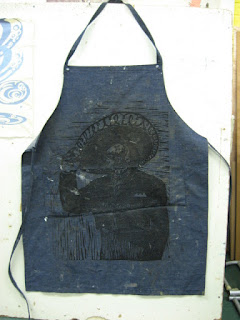Today's Class- We looked at the latest progress on the newest block, though we are still waiting to see the first proof of that block to see what it will actually look like. Followed up last week's discussion of block printing on fabric, looking at actual examples and discussing materials that can be used.
This lead to a discussion of Drive By Press, an artist run printmaking group. Founded by printmaking students from the midwest, what started as in independent project evolved into an industry. A small roller press was mounted on the back of a pickup truck and this truck has travelled the country, bringing a supply of carved blocks to all kinds of locations. Sometimes they went to places that had established studios and permanent equipment, including right here at Kean University. Wherever they went, those in attendance could receive a print from any of those blocks, printed on paper, but usually cloth. They would put it right on something you provided for a small fee, sell you a shirt with a print, or even put it on paper if you preferred. Below we see how a block could be printed on an apron, and the resulting piece, created right in VE 209.
Their visits included lectures on the history of their project and of printmaking in general, as well as displays of prints from many artists, such as the large composite relief print on cloth shown above, or a few highlights from their collection of works on paper from artists they were friends with.
They even helped to develop their own brand of relief ink, specially formulated for block printing on fabric, as in this t-shirt from 2010.
For next class- I expect to see the next block proofed, as well as get an update on the mixed media experiments that we were discussing this afternoon.

































